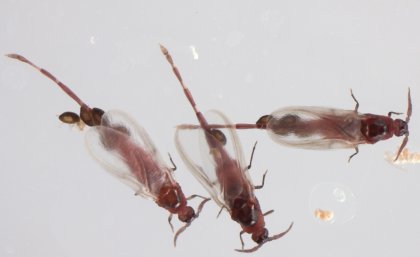
A University of Queensland graduate has identified a previously unknown species of insect living within reach of Australian suburbia.
UQ School of Biological Sciences Honours graduate Thomas Semple investigated the insect responsible for bush coconuts in South East Queensland last year as part of his studies.
“Bush coconuts, also known as bloodwood apples, are a type of bush tucker,” Mr Semple said.
“Although their names sound like fruit, they are actually growths on plants – galls – triggered by the feeding of a very strange insect.”
Mr Semple said until recently there were only two known species of the insect Cystococcus that lives inside these galls.
They typically occur in the savannah woodlands of northern Australia, but populations of different bush coconuts were recently found in Crows Nest National Park west of Brisbane, and in Toohey Forest in the heart of Brisbane.
Because they were found well outside their normal range, Mr Semple set about determining whether these populations represented a new species.
"We collected samples of the newly discovered populations from around South East Queensland, as well as the two other species from right across northern Australia," Mr Semple said.
"Using a combination of physical characteristics and DNA sequence data, I was able to determine that it was a species new to science."
Mr Semple said the insects displayed sexual dichronism, with females giving birth first to males, and then to females once the males had almost matured inside the gall.
“The wingless female nymphs cling to their winged adult brothers, hitching a ride out of the maternal bush coconut gall when the males fly to find mates,” Mr Semple said.
“This bizarre behaviour is called intersexual phoresy.”
Mr Semple, with help from collaborators in Australia, the United Kingdom and the US, has published his findings in the international journal Invertebrate Systematics.
He has named the newly recognised species Cystococcus campanidorsalis, with the second part of the scientific name referring to the insect's bell-shaped back that plugs the entrance to the gall.
"Insects are an incredibly diverse group of organisms, and this discovery shows that there are new species literally hiding in plain sight – right in the middle of Brisbane and along popular walking tracks," Mr Semple said.
"If you look closely enough, you'll find interesting insects everywhere, and maybe even something that no one else has seen before."
Mr Semple’s UQ Science Honours project was supervised by Dr Lyn Cook. He has started a PhD at the Australian National University in Canberra.
Media: Mr Thomas Semple, thomas.semple@uqconnect.edu.au.
.jpg)











